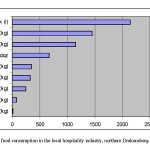Mudar Adas | On Friendship/(Collateral Damage) III
Joods Cultureel Kwartier: Minisymposium ~ De joodse diaspora in perspectief. 18 december 2019
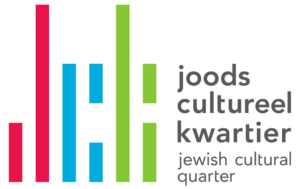 Weinig ervaringen hebben zo veel invloed gehad op de joodse identiteit als het leven in de diaspora. Het jodendom is voor een belangrijk deel ontstaan buiten het Beloofde Land.
Weinig ervaringen hebben zo veel invloed gehad op de joodse identiteit als het leven in de diaspora. Het jodendom is voor een belangrijk deel ontstaan buiten het Beloofde Land.
In Babylonië en Egypte leefden al vroeg gemeenschappen die zich als ‘Judees’ of ‘joods’ definieerden, misschien al eerder dan in Judea het geval was.
Recent gepubliceerde kleitabletten en papyri werpen een verrassend nieuw licht op deze vroege diaspora. Reden voor het Joods Historisch Museum om in samenwerking met het Menasseh ben Israel Instituut, het Nederlands Genootschap voor Joodse Studiën en de Universiteit van Amsterdam een studiedag te beleggen. Een keur aan Nederlandstalige specialisten geeft inzicht in de huidige stand van zaken in het onderzoek.
Zie voor programma: https://jck.nl/event/minisymposium-de-joodse-diaspora-perspectief?
Marianne van Tilborg | On Friendship / (Collateral Damage) III
Shulamit Bruckstein Coruh | On Friendship/(Collateral Damage) III
Lumen Travo Gallery ~ Opening “On Friendship/(Collateral Damage) III – The Third GaLUT”, 7th September h 17:00
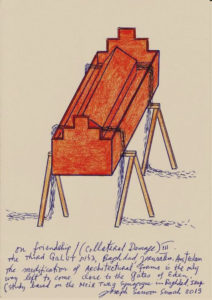 Lumen Travo gallery is thrilled to invite you to its first exhibition of the new season: the solo show by artist Joseph Sassoon Semah, who will share his lost rich Jewish Babylonian cultural heritage through art, performances and debates.
Lumen Travo gallery is thrilled to invite you to its first exhibition of the new season: the solo show by artist Joseph Sassoon Semah, who will share his lost rich Jewish Babylonian cultural heritage through art, performances and debates.
On Friendship/(Collateral Damage) III – The Third GaLUT: Baghdad, Jerusalem, Amsterdam is an aesthetic and poetic research into the cities Baghdad, Jerusalem and Amsterdam, which has been conceived by artist Joseph Sassoon Semah and curated by Linda Bouws (Metropool International Art Projects).
All these cities are said to have been tolerant at some time in their history, but how does that relate to ‘otherness’ and what does it mean today?
The project focuses on two lines of thought. The first is what Semah called ‘The Third GaLUT’, the third Exile, a metaphor for disconnectedness.
The second is ‘The Guest’, he who is allowed to live and work in a foreign context tests his surroundings the very moment he articulates his particular position in exile without any reservations. The Guest becomes Host. By this process Semah investigates one of the greatest achievements of human civilisation: hospitality. Joseph Sassoon Semah translates his cultural and visual heritage and its subtext into contemporary art. While doing so he reassesses and redefines lost heritages.
Opening on the 7th September, 17:00-19:00 hrs.
Exhibition running till the 12th October 2019.Besides the show at Lumen Travo, this manifestation will take place in 35 different public locations in Amsterdam, from September 7th-January 19th 2020.
Simultaneously in Amsterdam, Baghdad and Jerusalem a small house will be built: MaKOM in MaKOM.
The project is aiming to translate the cultural heritage of Baghdad, Jerusalem, and Amsterdam, with the help of the different ‘Guests’, into a meaningful experience for a broad audience.
On Friendship/(Collateral Damage) III – The Third GaLUT: Baghdad, Jerusalem, Amsterdam was realised in part with the support of AFK, BPD Cultuurfonds, Lumen Travo Gallery, Mondriaan Fonds and Redstone Natuursteen & Projecten.
Joseph Sassoon Semah was born in Baghdad (Iraq, 1948), as one of the last of a Babylonian Jewish family lineage. Baghdad once was one of the most diverse an tolerant cities in the world. The Babylonian Jews in Iraq were one of the oldest and historically seen, the most important Jewish community. But from 1948, the year of independence for Israel, life for Jews in Iraq becomes extremely difficult.
Between 1950-1952, 120.000 – 130.000 Iraqi Jews were transported to Israel. The displaced Baghdadi Jews were forced to leave behind their culture and possessions in Iraq. Semah, together with his parents was displaced to the State of Israel in 1950.
As a Babylonian Jew who emigrated to the West (Amsterdam), he is part of GaLUT (Exile), an endless cycle of diaspora and return. You long for your country of birth and search for a way to relate to your cultural heritage and traditions.
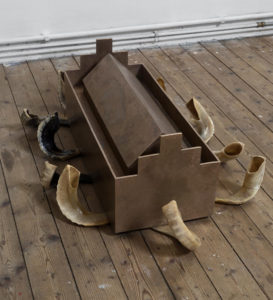
Joseph Sassoon Semah – On Friendship / (Collateral Damage) III -The Third GaLUT: Baghdad, Jerusalem, Amsterdam, 2019 (Between Graveyard and Museum’s Sphere) 2019 Model based on Synagogue Meir Tweig, Baghdad, Iraq Bronze, 10 ShOFaROT, 70x30x33cm Photo: Ilya Rabinovich
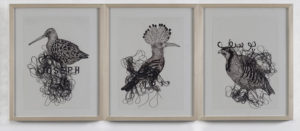
Joseph Sassoon Semah – On Friendship / (Collateral Damage) III -The Third GaLUT: Baghdad, Jerusalem, Amsterdam, 2019 Jusuf/Yosef/Joseph drawings,sepia ink on paper, brown thread, glass, wood Size: 3 x 50×40 cm Photo: Ilya Rabinovich
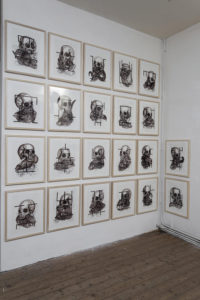
Joseph Sassoon Semah – On Friendship / (Collateral Damage) III -The Third GaLUT: Baghdad, Jerusalem, Amsterdam, 2019 22 drawings, sepia ink on paper, brown thread, glass, wood, 50x40cm Photo: Ilya Rabinovich
How To Explain Hare Hunting To A Dead German Artist
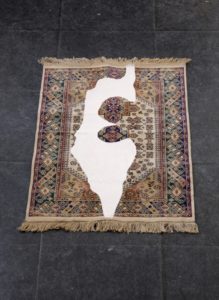
Joseph Sassoon Semah, My Beloved Country – That Did Not Love Me, rug and black oil paint, 100X70 cm, 1977 Photography: Ilya Rabinovich – Courtesy of Joseph Sassoon Semah
Joseph Sassoon Semah, a Baghdad-born artist who now lives and works in Amsterdam, is about to embark on an extensive multi-site project, in Amsterdam, Jerusalem, and Baghdad. Berlin-based poet and author Mati Shemoelof talks with him about his years living as an artist in Israel versus being a Babylonian Jew and an artist in Europe. They discuss Judaism, diaspora, exclusion, and acts of concealment and building.
The artist Joseph Sassoon Semah has never before given an interview to an art publication in Israel. The Israeli art world has not adequately recognized his work. Although he showed in several important institutions in Israel and worked with key curators, it was negligible compared with the scope of his oeuvre, especially following his move from Israel to Europe. What would have happened had he stayed in Israel? Was he stumped by his diasporic state or was he ahead of his time in dealing with the Jewish component of his art? It is not merely an objective issue to be measured by the number of exhibitions, but rather the artist’s subjective sense of his position in the art field. I gather from Semah that he has remained on the outside, beyond the walls of Jerusalem. In Europe, too, and especially in the Netherlands, his work is not widely known yet. This interview stems from my own interest in Semah’s identity (we are both of a Jewish Iraqi descent) and his work, but also as an intra-European process of an artistic, inter-generational analysis attempting to formulate the role of Jewish culture in Europe.
Semah was born in Baghdad, Iraq, in 1948. His grandfather, Hacham Sassoon Kadoorie, was the chief rabbi of Baghdad’s Jewish community until his passing in 1971, even after they had all emigrated. In 1950, Semah and his family were uprooted from Iraq, and they moved to Israel. He grew up in Tel Aviv. Traumatized by his military service in the 1967 and 1973 wars, he chose exile and has been living in the Netherlands since 1981. The grandfather’s continued residence in Baghdad, along with some 20,000 more Jews, brings to mind Semah’s own position in Amsterdam (his grandfather did not immigrate to Israel, and Semah emigrated from Israel – both had chosen a diasporic existence as a Jewish minority under a Muslim/Christian majority), where he now lives with his partner, Linda Bouws. She runs the institute they co-founded, Metropool – Studio Meritis MaKOM: International Art Projects. My grandmother, Rachel Kazaz, had also been among the displaced Baghdadi Jews. My acquaintance with the pain and the uprooting enabled me to write about the mysterious affair that drove the Jews of Iraq to abandon their property, their culture, and their way of life within just a year; the affair that involved bombing Jewish centers in Baghdad, including the synagogue of Semah’s grandfather. [i] Read more


